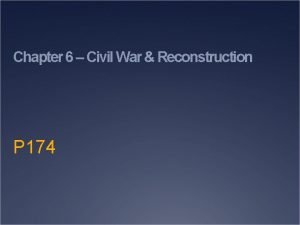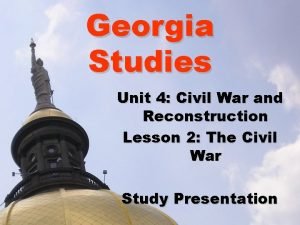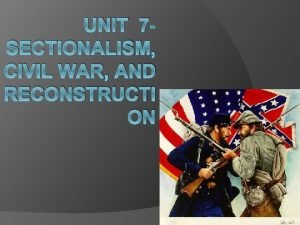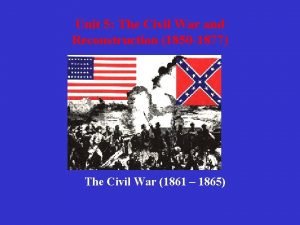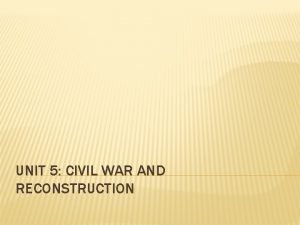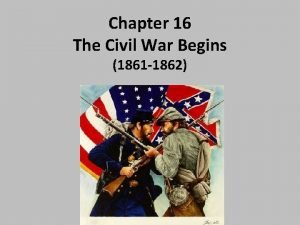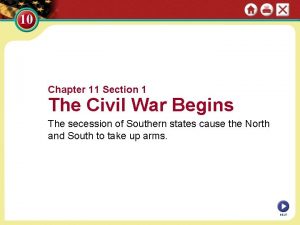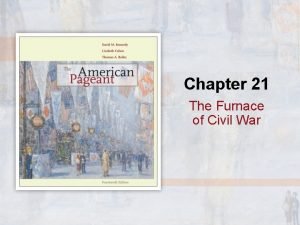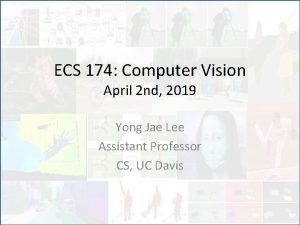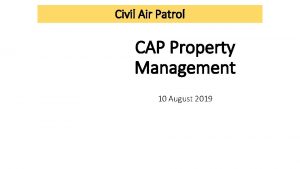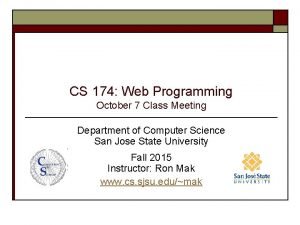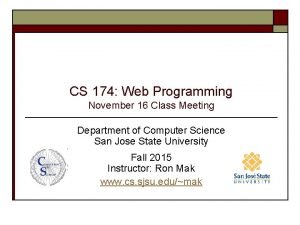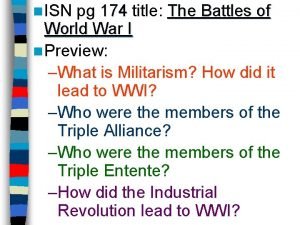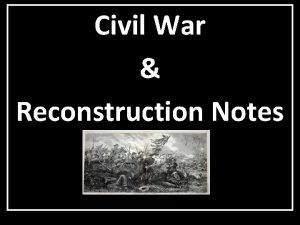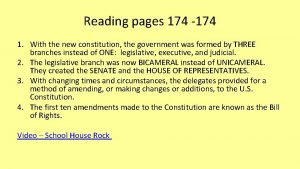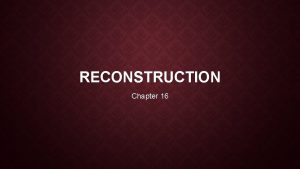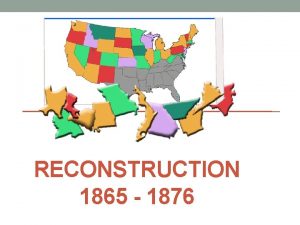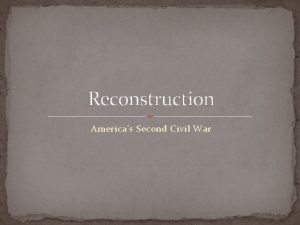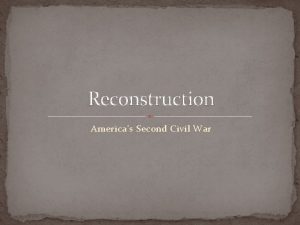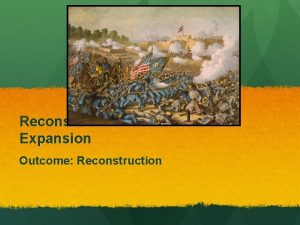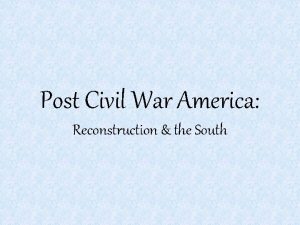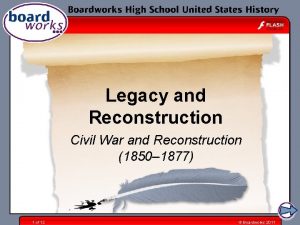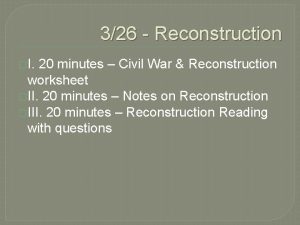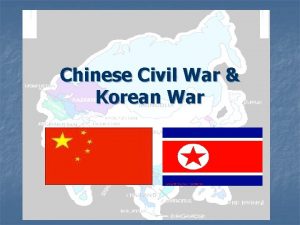Chapter 6 Civil War Reconstruction P 174 Ch


























- Slides: 26

Chapter 6 – Civil War & Reconstruction P 174

Ch 6 Overview Ü Lesson 1 – Early years of Civil War Ü Lesson 2 – hardships faced by soldiers & civilians during the war Ü Lesson 3 – describes how the North won the war Ü Lesson 4 – Reconstruction Ü Lesson 5 – challenges faced by former slaves after the end of Reconstruction Ü Begin p 176

Ch 6 Lesson 1 – A Nation at War Ü Vocab: border states, casualties, draft, emancipation Ü Objectives: Ü U 3 -10: Compare strengths of Confederacy & Union Ü U 3 -11: Identify important early battles and events of the Civil War Ü U 3 -12: Describe the significance of the Emancipation Porclamation

Ch 6 L 1 – p 176 Ü The Confederacy’s plan for winning the war was to fight off northern attacks until the Union gave up and to get help from Britain & France Ü At the battle of Antietam, the Union army stopped General Lee from invading the North. The armies suffered a combined 22000 casualties Ü Jefferson Davis, president of the Confederacy (South) couldn’t get enough food, $, & weapons because the Union blockade closed most southern ports. Davis had to start a draft b/c not enough people wanted to join the army. The Confederate states ignored his orders b/c they didn’t want to give up their power

Ch 6 L 1 Ü Lincoln issued the Emancipation Proclamation b/c he knew that freeing the enslaved people could hurt the Confederacy. Enslaved people who worked on southern farms could help the North instead Ü The Battle of Gettysburg was a turning point of the war b/c about ½ of General Lee’s men were killed or wounded. The Confederate army was so weakened that their army had to retreat

Objectives & Summary Ch 6 L 1 Ü Confederacy strengths included fighting on home turf & talented military commanders. Union advantages were greater population, more factories (= more $), and more railroad lines Ü Important battles = 1 st battle of Bull Run, Battle of Antietam, Vicksburg & Gettysburg Ü Emancipation Proclamation declared enslaved people in the Confederacy free and turned slavery into the key issue of the war

Ch 6 L 2 – The Human Face of War p 184 Ü Vocab: camp, homefront, civilian Ü Objectives: Ü U 3 -13: Describe conditions that soldiers faced during Civil War Ü U 3 -14: Explain how the war affected people on the home fronts both in North & South Ü Clara Barton: headed the American Red Cross

Ch 6 L 2 p 184 Soldiers faced many problems Life on the home front was difficult Not enough food Women ran their families’ homes & businesses Dangers in battle & from diseases Civilians in the South did not have enough food

Ch 6 L 2 Ü Women on both sides of the war dressed as men and joined the army, spied, cared for the sick & wounded Ü Soldiers read, sang, & wrote letters to eliminate boredom of camp life. Others put on shows or printed newspapers Ü Immigrants from Germany, Ireland, & Italy joint the Union army Ü The Civil War was so deadly because rifles could shoot farther and more accurately than ever, and disease killed twice as many soldiers as fighting did

Ch 6 L 2 Ü Women ran farms & businesses. Thousands sewed uniforms, knitted socks, made bandages & raised $$ for both armies. Some were nurses Ü Confederate $$ became almost worthless this Inflation made food and other items very expensive

Objectives & Summary Ch 6 L 2 Ü Soldiers lived in camps, where they waited for news from home. Powerful rifles & rampant disease led to many casualties Ü Home front effects included inflation and hunger in the South & personal losses to families in the North & South. Many women had to take over traditionally male responsibilities

Overview Union Soldiers Ate poor food; Some were immigrants & African Americans Confederate Soldiers Did not have enough food

Ch 6 L 3 – The War Ends p 190 Ü Vocab: telegraph, total war, desert Ü Objectives: Ü U 3 -15: Explain factors, including strategy of total war, which helped Union defeat Confederacy Ü U 3 -16: Describe end of war, including Lee’s surrender to Grant Ü Telegraph messages were sent by Morse code, a system of patters of dots & dashes created by inventor Samuel Morse Ü William Tecumseh Sherman went to West Point as a young man. After graduating, he served several military assignments in the South, which helped him learn about southern people & geography

Ch 6 L 3 p 190 Ü General Grant planned to end the war by leading an army to defeat General Lee’s soldiers and capture Richmond. At the same time, General Sherman’s army would attack Atlanta Ü During Sherman’s march at Sea, Sherman’s army marched though Georgia from Atlanta to Savannah, destroying nearly everything they passed Ü Grant’s army received food, supplies & soldiers while in Richmond. The Confederate army was running out of reinforcements Ü Lee surrendered to Grant at Appomattox Court House on April 9, 1865

Ch 6 L 3 Objective & Summary Ü Factors that helped the Union defeat the Confederacy were greater availability of soldiers and supplies in the North & Sherman’s strategy of total war, which devastated much of the South Ü The war ended with Lee’s surrender to Grant after a long face-off near Richmond and increased desertion by Confederate troops

Sequence of Events leading to the END of the WAR Sherman’s March Lee & Grant face each other near Richmond Confederate Army runs out of supplies Lee surrenders

Ch 6 L 4 – Reconstruction p 196 Ü Vocab: reconstruction, assassination, Freedmen’s Bureau, impeach Ü Objectives: Ü U 3 -17: Compare different plans for reuniting the country and rebuilding the South after the Civil War Ü U 3 -18: Describe how the Constitution changed to protect the rights of African Americans after the war

Ch 6 L 4 p 196 Some people wanted to punish the South Some people wanted to make it easy for the South to come back to the Union Some people wanted to protect the rights of African Americans The country could not agree on how to rebuild the South

Ch 6 L 4 Ü Reconstruction was a huge challenge for Americans b/c the South had to be reunited w/ the rest of the country, but Americans could not agree on how it should be done Ü Lincoln planned to let the southern states set up new state gov’ts and quickly rejoin the Union Ü Booth assassinated Lincoln b/c he supported the Confederacy & was angry about the South’s defeat

Ch 6 L 4 Ü Black Codes were laws passed by southern states to limit rights of former enslaved people to travel, vote, & work in certain jobs Ü The purpose of the Freedman’s Bureau was to provide food, clothing, medical care, & legal advice to poor blacks and whites. It set up hospitals & schools for newly freed people Ü Congress took over reconstruction & put the South under military rule. Then Congress tried to impeach President Johnson – but failed

Ch 6 L 4 Ü Carpetbaggers were people from the North who went South to make $$ during Reconstruction Ü Scalawags was a slang for an old worthless horse but was used to refer to those southerners who helped the gov’t during Reconstruction Ü KNOW that the 13 th amendment abolished slavery in the US Ü 14 th Amendment = gave African Americans full citizenship & guaranteed due process of law Ü 15 th Amendment = gave African American men the right to vot Ü Many African Americans began taking part in gov’t, ran for office & became gov’t leaders after winning right to vote

Ch 6 L 4 Objective & Summary Ü After the war some northerners wanted to punish the South; Lincoln wanted to let the South rejon the Union easily; Radical Republicans wanted to change the South, especially with regard to African Americans’ rights Ü The Constitution’s 13 th Amendment ended slavery; 14 th Amendment full citizenship to African Americans; 15 th Amendment African American men right to vote

Ch 6 L 5 – The Challenge of Freedom p 206 Ü Vocab: sharecropping, Jim Crow, segregation Ü Objectives: Ü U 3 -20: Explain the effects of Reconstruction policies on the South after the Civil War Ü U 3 -21: Describe the end of Reconstruction in the South Ü Background/Info on the Tuskegee Institute – The Tuskegee Institute began w/ $2000 for teachers’ salaries but nothing for land or buildings. Booker T. Washington got a $200 loan to purchase land for the school. Students built its first buildings and grew food for the school. Wealthy people such as Andrew Carnegie & John D Rockefeller contributed to the Tuskegee Institute

Ch 6 L 5 Ü Sharecropping: a farmer keeps a part (or a share) of a crop & gives the rest to the landowner Ü Benefits of sharecropping: landowners let poor farmers farm small areas of land in return for a share of the crop Ü Sharecroppers usually stayed poor because they owed $$ to the landowners, making it hard to get out of debt Ü Many freed African Americans became sharecroppers b/c they wanted to be farmers but could not afford to buy land

Ch 6 L 5 Ü Many Americans felt disappointed with Reconstruction b/c they felt it has not successfully reunited the nation Ü Jim Crow laws refer to laws that promoted segregation and unequal treatment during this time period Ü Jim Crow laws segregated schools, hospitals, cemeteries, etc. Ü George Washington Carver is known for studying the peanut & credited for its’ many uses

Challenges of newly freed African Americans Jim Crow laws Lack of good schools & hospitals African Americans faced challenges segregation sharecropping
 Chapter 6 civil war and reconstruction
Chapter 6 civil war and reconstruction Unit 4: civil war and reconstruction
Unit 4: civil war and reconstruction Civil war and reconstruction study guide
Civil war and reconstruction study guide Remembering world war 1 achieve 3000
Remembering world war 1 achieve 3000 Unit 5 civil war and reconstruction
Unit 5 civil war and reconstruction Reconstruction vocabulary words
Reconstruction vocabulary words Civil war first modern war
Civil war first modern war Toward civil war lesson 3 secession and war
Toward civil war lesson 3 secession and war Chapter 16 the civil war begins worksheet answers
Chapter 16 the civil war begins worksheet answers The civil war begins chapter 11 section 1
The civil war begins chapter 11 section 1 Chapter 21 the furnace of civil war
Chapter 21 the furnace of civil war Civil rights webquest
Civil rights webquest Chapter 30 the war to end war
Chapter 30 the war to end war Chapter 30 the war to end war
Chapter 30 the war to end war Opwekking 349 tekst
Opwekking 349 tekst To kill a mockingbird page 174 line 8 word 3
To kill a mockingbird page 174 line 8 word 3 Ecs 174
Ecs 174 Capr 174-1
Capr 174-1 174 petawatts
174 petawatts Sjsu cs 174
Sjsu cs 174 Cs 174
Cs 174 174/116 blood pressure
174/116 blood pressure Alo 174 afiş
Alo 174 afiş Art.174 kp
Art.174 kp Te escribo porque mi hermana tatiana
Te escribo porque mi hermana tatiana 174/300 simplified
174/300 simplified Pg 174
Pg 174
